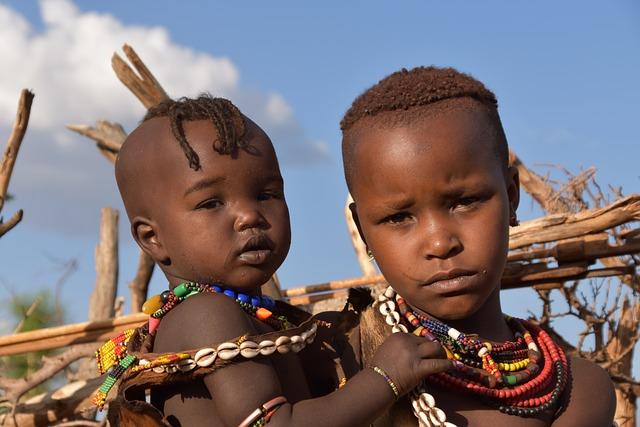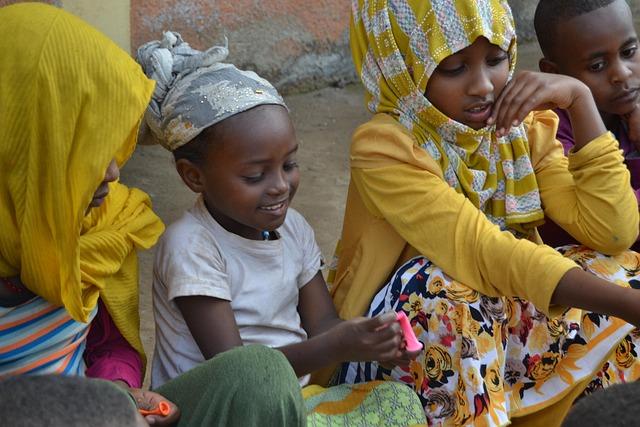In the Horn of Africa, tensions are escalating between Ethiopia and Eritrea, raising alarms about a potential resurgence of conflict in a region already fraught with instability. Recent statements from officials in the Tigray region, long caught in the crossfire of political and military strife, underscore the precarious situation as they warn that a renewed war may be imminent. Despite recent efforts to foster peace and reconciliation, underlying grievances and military posturing threaten to unravel these fragile advancements. This article delves into the historical context of the Ethiopia-Eritrea relationship, the current dynamics in Tigray, and the implications of this renewed hostilities for the region as a whole. As diplomatic efforts face significant challenges, the specter of conflict looms large, making it imperative to closely monitor developments in this pivotal area.
Ethiopia and Eritrea on the Brink of Conflict as Tensions Escalate
Recent developments have painted a concerning picture for the Horn of Africa, where escalating tensions between Ethiopia and Eritrea are stirring fears of renewed conflict. Officials from the Tigray region have raised alarms over increased military activity along the border, citing reports of troop movements and heavy artillery being stationed in strategic locations. Observers note that the fragile ceasefire established after the Tigray conflict has faltered, with diplomatic efforts struggling to quell the animosities that have lingered since the two nations were embroiled in war two decades ago. Key factors contributing to the rising tensions include:
- Border Disputes: Ongoing disagreements over territory continue to fuel hostilities.
- Military Build-up: Reports of both nations enhancing their military capabilities.
- Political Rhetoric: Nationalist sentiments are being stoked by leadership remarks from both sides.
- Resource Scarcity: Competition over water and other resources exacerbates conflicts.
The situation remains fluid, with potential repercussions not only for Ethiopia and Eritrea but for the broader region. Analysts fear that a full-scale return to warfare could further destabilize an already volatile area. humanitarian concerns are also arising, as escalating violence could lead to mass displacement, exacerbating the existing crisis that has affected millions in Tigray and surrounding areas. As the international community watches closely, the following factors play a critical role in determining the future landscape:
| Factor | Impact |
|---|---|
| Diplomatic engagement | Pivotal for reducing hostilities. |
| International Pressure | Can influence political leaders to avoid escalation. |
| Economic Sanctions | May serve as a deterrent against militarization. |
Understanding the Role of Tigray Leadership in the flare-up
The recent escalation of tensions in the Horn of Africa has brought the leadership dynamics within Tigray into sharp focus. After a prolonged conflict, the Tigray People’s Liberation Front (TPLF) has been at the center of discussions regarding the potential for renewed violence, especially in light of the warnings issued by Tigray officials about a looming war between Ethiopia and Eritrea. Key factors influencing Tigray’s position include:
- Historical grievances: The leadership’s memories of the devastating impact of the previous conflict with the Ethiopian federal government shape their current posture.
- Alliances and opposition: Tigray’s leaders are acutely aware of their alliances with other ethnic groups and the shifting allegiances in the region.
- Negotiation strategies: The Tigray leadership’s approach to discussions with the federal government reflects their desire to safeguard regional autonomy while seeking peace.
as tensions rise, the leadership’s actions and communications are critical in shaping both local and international perceptions of the situation. Understanding how Tigray’s officials interpret their role amid these complexities can provide valuable insights into the broader geopolitical landscape. The implications of their decisions extend beyond territorial claims, impacting humanitarian efforts, diplomatic relations, and regional stability. A brief overview of Tigray’s leadership strategies includes:
| Strategy | Description |
|---|---|
| Defensive Posturing | Emphasizing security and protection of Tigray against perceived external threats. |
| Diplomatic Outreach | Engaging with international actors to mediate and facilitate dialog. |
| Mobilizing Support | Rallying local communities around a shared identity and resilience against aggression. |
historical Context: The Legacy of War Between Ethiopia and Eritrea
The long-standing tensions between Ethiopia and Eritrea have roots that stretch back to the late 19th and early 20th centuries, with both nations deliberately shaped by colonialism and subsequent independence movements. The struggle between the two countries culminated in a violent conflict from 1998 to 2000, which left deep scars on both societies. The 2000 peace agreement, while initially viewed as a turning point, did not eliminate the underlying disputes, particularly over the border demarcation. This unresolved legacy has fostered an atmosphere of mistrust and hostility, continuing to influence political dynamics in the Horn of Africa.
As recent warnings from Tigray officials suggest a possible resurgence of conflict, the implications of renewed hostilities could be catastrophic not only for Ethiopia and Eritrea but also for regional stability. Key factors contributing to this volatile situation include:
- Historical Grievances: The memories of past conflicts exacerbate current relationships.
- Political Fragmentation: Internal divisions within Ethiopia complicate diplomatic efforts.
- Regional Alliances: Shifting allegiances among neighboring countries can impact international responses.
With interlinked pasts and a precarious present, the possibility of war remains a troubling prospect for the people of both nations, demanding international attention to help mediate disputes and foster lasting peace.
International Response: The Need for Diplomatic Intervention
The escalating tensions between Ethiopia and Eritrea, particularly concerning the tigray region, have invoked alarm among the international community. With the specter of potential conflict looming, it’s crucial for global actors to weigh in before the situation deteriorates further. A coordinated response can potentially mitigate the risks of war through diplomatic channels,involving both regional and international stakeholders. Key strategies may include:
- Negotiation Facilitation: Engaging neutral parties to mediate talks between Ethiopian and Eritrean leaders.
- Pressure for Peace: Utilizing economic and political leverage to promote a ceasefire and de-escalation of military activity.
- Humanitarian Assistance: Mobilizing support for civilians affected by the conflict to alleviate immediate suffering and foster goodwill.
along with immediate diplomatic efforts,a long-term strategy is necessary to address the underlying issues fueling tensions. International organizations, including the United Nations and the African Union, could play pivotal roles by establishing a framework for enduring peace through:
| Action | Description |
|---|---|
| Conflict Resolution Workshops | Training local leaders in conflict resolution and negotiation techniques. |
| Regional security Initiatives | Collaborative security frameworks involving neighboring countries to ensure stability. |
| Socioeconomic Advancement Programs | Investment in joint projects to foster economic interdependence between nations. |
Recommendations for Peace: Strategies to De-escalate Tensions
to navigate the escalating tensions between Ethiopia and Eritrea, a multilateral approach is essential. Engaging regional organizations such as the African Union can facilitate dialogue,creating a platform for both nations to express their grievances and aspirations. Third-party mediation should also be employed, leveraging neutral states or international entities that can bring both sides to the negotiating table. Establishing communication hotlines between military leaders could prevent misunderstandings and accidental escalations, providing a channel for immediate dialogue in times of crisis.
Furthermore, implementing joint economic initiatives can foster interdependence, reducing the incentive for conflict. Collaborative ventures in areas like water resource management or trade partnerships might shift the focus from rivalry to mutual benefits. Building cultural exchange programs can also promote understanding among the people, emphasizing shared history and common goals. it is crucial to prioritize grassroots peacebuilding efforts within local communities, ensuring that citizens on both sides advocate for harmony rather than hostility.
The Humanitarian Crisis: Impacts on Civilians and the Path Forward
The escalating tensions between Ethiopia and Eritrea have given rise to a serious humanitarian crisis that puts civilians in the crossfire. reports indicate that communities in regions close to the Tigray border are already feeling the brunt of the looming conflict. As governmental forces ramp up military readiness, many innocent lives hang in the balance. Key factors contributing to the civilian plight include:
- displacement: Thousands might be forced to leave their homes, seeking safety amidst the uncertainty.
- Access to Resources: Limited access to food, clean water, and healthcare exacerbates the dire situation for those already affected by ongoing conflict.
- Psychological Impact: The fear and trauma associated with potential war can lead to long-term mental health issues for the affected populations.
Addressing the challenges posed by such a humanitarian crisis will require immediate and coordinated action from local authorities, NGOs, and international organizations. Potential strategies to alleviate the suffering of civilians may include:
| Strategy | Description |
|---|---|
| Humanitarian Aid | Mobilizing resources to deliver essential supplies to impacted areas. |
| Diplomatic Engagement | Encouraging dialogue between conflicting parties to de-escalate tensions. |
| Community Support | Providing psychosocial support to help individuals cope with trauma. |
In Retrospect
the escalating tensions between Ethiopia and Eritrea, as highlighted by the alarming warnings from Tigray officials, underscore a precarious situation that could potentially destabilize the Horn of Africa further. As regional dynamics shift and historical grievances resurface,the implications of renewed conflict would extend beyond the borders of these two nations,affecting humanitarian efforts and regional security. It is crucial for international stakeholders to engage diplomatically and work toward a peaceful resolution to avoid a broader crisis.The situation remains fluid, and continued monitoring of developments will be essential to understanding the full scope of this conflict and its impact on the region.

